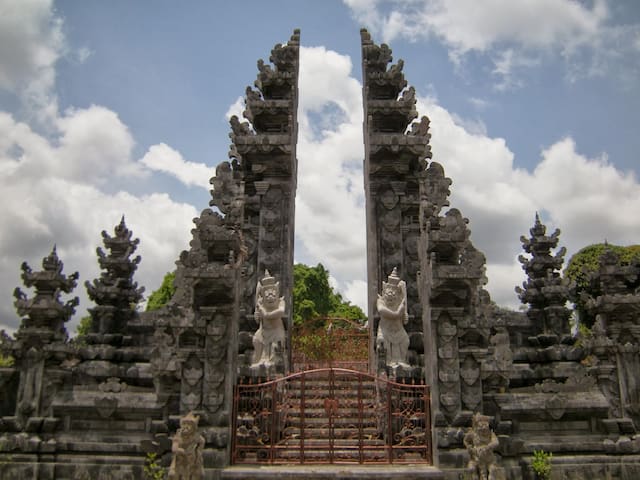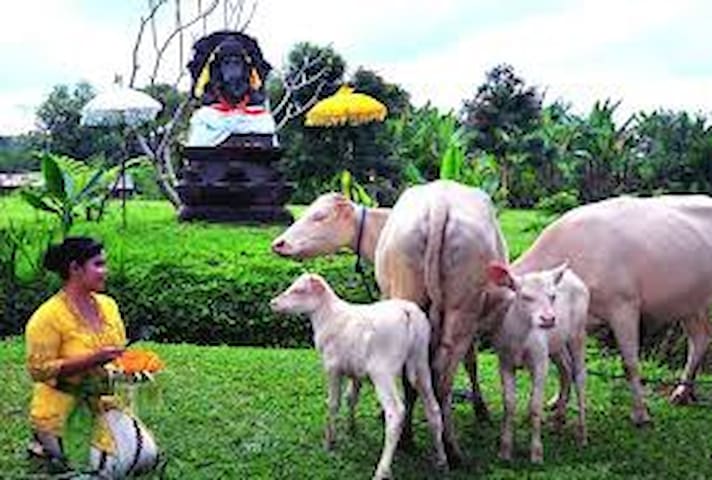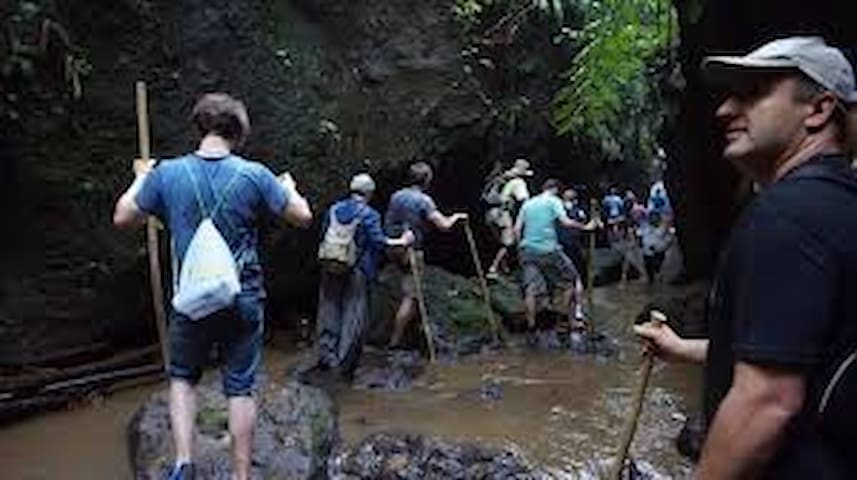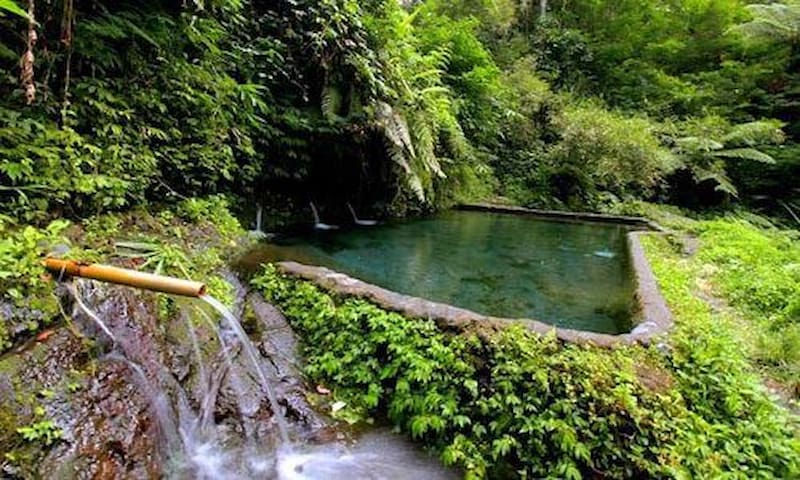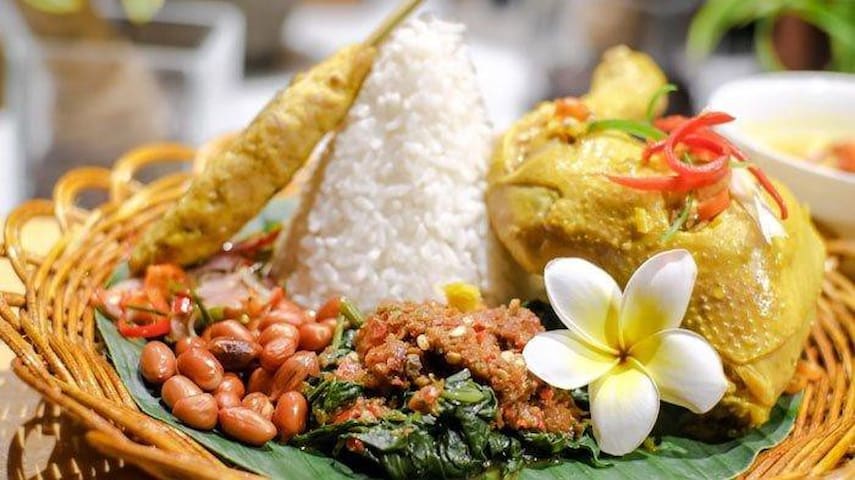History and culture
The history of Taro began when Rsi Markandya arrived in a dense forest beneath Mount Agung (northeastern Bali) where he tried to open residential and agricultural areas with his 8000-strong followers. However, their efforts were hampered by a deadly disease outbreak, leaving only about a half of his followers survived. Seeing this strange phenomenon, Rsi Markandya then meditated in hope of receiving guidance from The Almighty. He realized that they need to ask for permission first by offering a plowing ceremony of Panca Datu at Besakih Temple.
Afterward, Rsi Markandya and his followers accomplished their targets to build residential areas and agriculture around the mountain. Their expansion then widens to a very fertile region named Sarwa Ada which subsequently became the location of a religious school (Pasraman) named Pasraman Gunung Raung – a bid to satisfy The Almighty.
But somehow, he keeps struggling with plethora of problems and obstacles.
Feeling perplexed, he decided to return to Eastern Java to meditate, asking for more guidance. However, he was tipped that he should return to Bali and perform a meditation at the Pasraman. Assured by the guidance, Rsi Markandya acted accordingly and saw a glowing light came from a tree. He eventually decided to build a temple at the location. The temple was named Pura Gunung Raung and gradually became the center of the Taro village in Tegallalang Ubud as we know it. The name itself is derived from the word “taru” which literally means tree.
The history of Taro began when Rsi Markandya arrived in a dense forest beneath Mount Agung (northeastern Bali) where he tried to open residential and agricultural areas with his 8000-strong followers. However, their efforts were hampered by a deadly disease outbreak, leaving only about a half of his followers survived. Seeing this strange phenomenon, Rsi Markandya then meditated in hope of receiving guidance from The Almighty. He realized that they need to ask for permission first by offering a plowing ceremony of Panca Datu at Besakih Temple.
Afterward, Rsi Markandya and his followers accomplished their targets to build residential areas and agriculture around the mountain. Their expansion then widens to a very fertile region named Sarwa Ada which subsequently became the location of a religious school (Pasraman) named Pasraman Gunung Raung – a bid to satisfy The Almighty.
But somehow, he keeps struggling with plethora of problems and obstacles.
Feeling perplexed, he decided to return to Eastern Java to meditate, asking for more guidance. However, he was tipped that he should return to Bali and perform a meditation at the Pasraman. Assured by the guidance, Rsi Markandya acted accordingly and saw a glowing light came from a tree. He eventually decided to build a temple at the location. The temple was named Pura Gunung Raung and gradually became the center of the Taro village in Tegallalang Ubud as we know it. The name itself is derived from the word “taru” which literally means tree.
7 penduduk tempatan mengesyorkan
Taro
The history of Taro began when Rsi Markandya arrived in a dense forest beneath Mount Agung (northeastern Bali) where he tried to open residential and agricultural areas with his 8000-strong followers. However, their efforts were hampered by a deadly disease outbreak, leaving only about a half of his followers survived. Seeing this strange phenomenon, Rsi Markandya then meditated in hope of receiving guidance from The Almighty. He realized that they need to ask for permission first by offering a plowing ceremony of Panca Datu at Besakih Temple.
Afterward, Rsi Markandya and his followers accomplished their targets to build residential areas and agriculture around the mountain. Their expansion then widens to a very fertile region named Sarwa Ada which subsequently became the location of a religious school (Pasraman) named Pasraman Gunung Raung – a bid to satisfy The Almighty.
But somehow, he keeps struggling with plethora of problems and obstacles.
Feeling perplexed, he decided to return to Eastern Java to meditate, asking for more guidance. However, he was tipped that he should return to Bali and perform a meditation at the Pasraman. Assured by the guidance, Rsi Markandya acted accordingly and saw a glowing light came from a tree. He eventually decided to build a temple at the location. The temple was named Pura Gunung Raung and gradually became the center of the Taro village in Tegallalang Ubud as we know it. The name itself is derived from the word “taru” which literally means tree.
The Legendary Albino Cattle of Taro Village
There is a herd of legendary albino cattle in Taro, sanctified by the surrounding communities and Balinese society in general for its spiritual status: the vehicle of Lord Shiva; the bearer of the truth; and the symbol of the motherland. They also serve as witnesses for the Ngasti ceremony, in which the cattle is driven out from the forest and subsequently guided to circumnavigate the whole ceremony area. In this ceremony, the cattle will engage in Mepada (Maideran/Purwa Daksina) procession, where they start dwelling the area from east in a clockwise manner for as much as three times to finally stop again at the same point. After the procession, the cattle is then given offerings and delivered back to the forest.
These white cattle are believed to have inhabited the area prior to the arrival of Rsi Markandya, a Mahayogi (High Priest) from Eastern Java who came to Bali on a spiritual guidance
7 penduduk tempatan mengesyorkan
Taro
The Legendary Albino Cattle of Taro Village
There is a herd of legendary albino cattle in Taro, sanctified by the surrounding communities and Balinese society in general for its spiritual status: the vehicle of Lord Shiva; the bearer of the truth; and the symbol of the motherland. They also serve as witnesses for the Ngasti ceremony, in which the cattle is driven out from the forest and subsequently guided to circumnavigate the whole ceremony area. In this ceremony, the cattle will engage in Mepada (Maideran/Purwa Daksina) procession, where they start dwelling the area from east in a clockwise manner for as much as three times to finally stop again at the same point. After the procession, the cattle is then given offerings and delivered back to the forest.
These white cattle are believed to have inhabited the area prior to the arrival of Rsi Markandya, a Mahayogi (High Priest) from Eastern Java who came to Bali on a spiritual guidance
Explore the Nature of Taro
aro Village formerly known as Bhumi Sarwaada, is one of an ancient village in Bali related to the egendar holy priest of Mahayogi Rsi Markandeya who thought about Hinduism and agricultural system in Bali Called Subak. With his legacy still inheritted up to present generation, makes Taro village as an ideal place to explore culturally and naturally. The agriculture is still the main occupation of the local, it makes most of Taro nature is nicely preserve. We are more than happy to walk you through our magical sacred forest, lush tropical gardening plantation and green rice fields. if we are early enough. We may find birds singing melodies on gigantic trees during our path. The most interesting part of this journey is the river trekk. We start the journey from a Balinese Home. Where you will learn about Balinese compund and its structure. A freshly brewed Balinese coffee then to be served accompanied by crispy fried Banana ‘godoh” with a magnificinet view of a river gorges and caves. You will be guided to descend the river gorges called ‘Sampih’ and then walk through gigantic stones on the river flow, passing through breathaking canyon over shaky bamboo bridge. The trip is ended up in the local purification place called Yeh Pikat, where people is bathe to purify the body, sould and mind in a natural fresh spring water. The best part of this trip is the water fall, where you will be welcomed by a magical 8 meter river falls. You may stay as long as you like. An then a local balinese poridge is serve in the river to complete this one of a lifetime experience.
Taro
Lembah Bidadari
A hidden gems, reconnect with nature lembah bidadari is a nature swimming pool,
Local Food
in the village of Taro there are many local food available, from morning you can go to traditional market there are a delicious breakfast of some food such as balinese cake, rice, and fruits.
while you stay in govinda we serve food as well for breakfast, lunch and dinner.
7 penduduk tempatan mengesyorkan
Taro
in the village of Taro there are many local food available, from morning you can go to traditional market there are a delicious breakfast of some food such as balinese cake, rice, and fruits.
while you stay in govinda we serve food as well for breakfast, lunch and dinner.
Food scene
Semara ratih is a bamboo restaurant overlooking to lush green bamboo, rice terrace and river. this restaurant serve local food, indonesian and western, open for brunch and lunch.
Semara Ratih by Delodsema Village
Semara ratih is a bamboo restaurant overlooking to lush green bamboo, rice terrace and river. this restaurant serve local food, indonesian and western, open for brunch and lunch.
this is a uniqe place must visit during youb stay in taro. this place has restaurant, and fireflies conservation where you can see the fireflies. taste the local food and feel the vibes, rice terrace and sunset. if you have plan to do a romantic dinner, here is the best.
The Fire Flies Garden
this is a uniqe place must visit during youb stay in taro. this place has restaurant, and fireflies conservation where you can see the fireflies. taste the local food and feel the vibes, rice terrace and sunset. if you have plan to do a romantic dinner, here is the best.
things to do
this is what should you do during stay in taro, silver making class. Taro is also famous with an local artis who made a jewerly, stone carving, wood carving and many more.
Genuine Bali Experience
this is what should you do during stay in taro, silver making class. Taro is also famous with an local artis who made a jewerly, stone carving, wood carving and many more.

